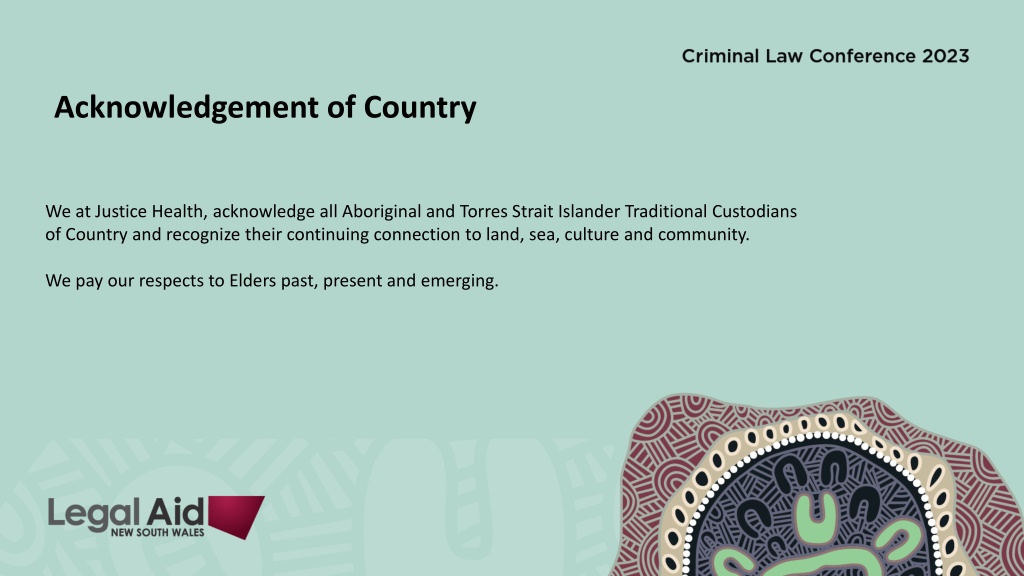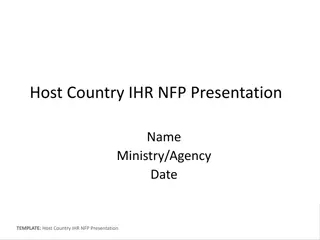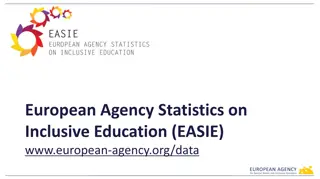Acknowledgement of Country
Acknowledging the impact of mental illness in legal settings, this content delves into identifying mental disorders, communicating effectively, and the importance of recognizing mental health issues. It highlights the prevalence of mental disorders in court-involved individuals, the criteria for mental illness, and the socio-economic factors influencing mental health outcomes. The statistics underscore the need for diversion programs to provide treatment instead of incarceration for mentally ill defendants.
Download Presentation

Please find below an Image/Link to download the presentation.
The content on the website is provided AS IS for your information and personal use only. It may not be sold, licensed, or shared on other websites without obtaining consent from the author. Download presentation by click this link. If you encounter any issues during the download, it is possible that the publisher has removed the file from their server.
E N D
Presentation Transcript
Acknowledgement of Country We at Justice Health, acknowledge all Aboriginal and Torres Strait Islander Traditional Custodians of Country and recognize their continuing connection to land, sea, culture and community. We pay our respects to Elders past, present and emerging.
Taking your cue from the clues: Identifying mental illness and / or cognitive problems and how to communicate effectively Ashanti Tong Clinical Nurse Consultant Dr Gordon Elliott Consultant Forensic Psychiatrist Professor David Greenberg Consultant Forensic Psychiatrist
What is a Mental Illness? I have mental problems I see someone for mental issues I m feeling a bit depressed As per the Mental Health Act 2007: A condition that seriously impairs, either temporarily or permanently, the mental functioning of a person and is characterized by the presence in the person of any one or more of the following symptoms- a) Delusions b) Hallucinations c) Serious disorder of thought form d) A severe disturbance of mood e) Sustained or repeated irrational behaviour indicating the presence of any one or more of the symptoms referred to in paragraphs (a) to (d)
Why is this so important? 1 in 5 Australians aged 16 85 experienced a mental disorder in the previous 12 months (ABS 2022). The prevalence of mental illness and mental disorders is far higher in individuals who appear before the courts (Butler 2001). Mental illness covers a range, including anxiety disorders, affective disorders, psychotic disorders and substance use disorders. Many people struggle with their mental health. It does not necessarily mean they have a mental illness. However, a person does not need to meet the criteria for a mental illness or mental disorder to be negatively affected by their mental health. Mental health is impacted by multiple socioeconomic factors, including a person s access to services, living conditions and employment status.
Statistics at a glance: Internationally the prevalence of serious mental illness in courts is approximately 7-10% 49% of inmates report a history of mental health treatment Even higher for Aboriginal inmates - 80% of Aboriginal women and 66% of Aboriginal men had a mental illness 140,000 persons are charged with an offence in NSW annually (approximately 6,000 are young people) Under the new NSW Mental Health & Cognitive Impairment Provisions) Act 2020, the Magistrate has the power to order a section 14 (community order) or a section 19 (hospital) thus diverting mentally ill defendants from the judicial system into the community for treatment in lieu of incarceration
Broad types of psychotic presentations - 1. Florid agitated, manic, markedly thought disordered, obviously deluded and/or responding to hallucinations. - 2. Guarded quiet, suspicious, questioning of questions, denying any history of mental illness despite evidence to the contrary - 3. chronic accommodated psychosis entrenched fixed delusions and/or voices, features of chronic SCZ including self neglect, homelessness - 4. first presentation psychosis - many different versions, but an absent history of care or treatment - 5. residual minimal to no psychotic symptoms, but obvious evidence of chronic schizophrenia including marked self neglect, minimal to no initiative or spontaneity, impoverished replies to questions, seeming indifference. - 6. catatonic seen less frequently now. Mute, holding odd posture
Clues for mental illness - History of psychiatric hospital admissions, especially admissions longer than a week, of community mental health team contact, of community treatment orders, of antipsychotic treatment especially long acting injectable medications or an antipsychotic requiring regular blood tests/monitoring - If they tell you! OR refusing to talk about their mental health, declining consent to liaise with GP/ mental health team/ family - Mental state examination - Clues on appearance include disorganized or eccentric clothing, self neglect - Slowed thinking, pauses, distraction, apparent indifference, incongruence between emotional state and topic - Thought disorder disjointed ideas, difficult to follow train of thought, rapid speech - Hallucinations and Delusions: Client is distracted, delayed responses, preoccupied with fixed false beliefs - Paranoia: suspicious, questioning your role, asking what you are noting down, darting eyes, whispering, quiet voice, - Concerning statements or actions: thoughts of self harm/ suicide; thoughts of harming others around them. Plan and/ or intent to act. Possession of means to act. - Mood: low mood to the point where they are not attending to basic daily care/ tasks,
Caution advised 1. If you re feeling unsafe, you probably are. 2. Patients who are obviously mentally ill, but insist they are not and further insist they don t need mental health care. 3. Manic patients driven, fast talking, quick to become enraged 4. Paranoid patients suspicious, questioning questions, incorporating you into their persecutory beliefs 5. Those with marked substance intoxication or withdrawal. Ie agitated, restless, sweating, distracted or rapidly shifting focus of attention 6. History of aggression to health care workers
Interview tips for the psychotic client Attempt to modify your environment (quiet space/ room or Explain your actions (closing/ open door, note taking, reading facts)- could exacerbate paranoia/ anxiety Interview tips (cues) for the psychotic client open outdoor space that protects privacy). Know where your duress is located. - Attempt to modify your environment (quiet space/ room or open outdoor space that protects privacy). Know where your duress is located. Provide extra time for the interview Speak in calm, slower but clear, simple terms - If possible, offer preference of speaking with male or female. With permission offer their - Minimize distractions (mobile on silent) as could exacerbate paranoia/ anxiety support person to sit in. - Explain your actions (closing/ open door, note taking, reading facts)- could exacerbate paranoia/ anxiety Keep your hands visible Minimize distractions (mobile on silent) as could exacerbate paranoia/ anxiety - Acknowledge their distress but don t empathize where you cannot I can t imagine but that must be a terrifying feeling - Speak in calm, slower but clear, simple terms - Avoid judgmental or defensive attitude/ tone Maintain regular eye contact Maintain regular eye contact (avert or lower your eyes as appropriate- particularly with Indigenous clients) - Out of custody- if you are concerned about their immediate safety (hurting themself or - If possible, offer preference of speaking with male or female. With permission offer their support person to sit in. others), call an ambulance and advise them of this. If possible, provide the ambulance with their residential address in the case they leave. If immediate risk is not an issue, contact the Mental Health Line to refer the client and advise them of this. - Acknowledge their distress but don t empathize where you cannot I can t imagine but that must be a terrifying feeling Avoid reinforcing a delusional belief. As part of your work, you must present them with the facts but if there is a delusion associated to the fact, avoid challenging it Keep your hands visible Avoid reinforcing a delusional belief. As part of your work, you must present them with the facts but if there is a delusion associated to the fact, avoid challenging it - Out of custody- if you are concerned about their immediate safety (hurting themself or others), call an ambulance and advise them of this. If possible, provide the ambulance with their residential address in the case they leave. If immediate risk is not an issue, contact the Mental Health Line to refer the client and advise them of this. Avoid judgmental or defensive attitude/ tone - Provide extra time for the interview
Clues for mental illness It is the clinicians job to find out if the symptoms and behaviours are genuine or malingered in nature. Your main goal is to obtain as much information as possible from the client by ensuring they feel as safe and well supported as possible. There is a strange, entirely unfounded superstition even among psychiatrists that if a man simulates insanity, there must be something mentally wrong with him in the first place. As if a sane man would not grasp at any straw if his life were endangered by the electric chair (Wertham, 1949).

























